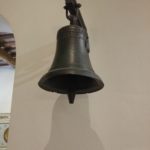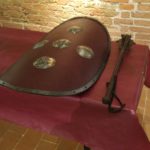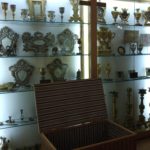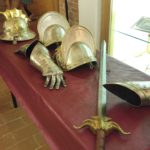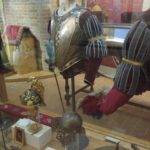The Days Before the Race
Before I arrived, my understanding of Siena was that it was a “medieval Italian city.” This is certainly true, but what this description does not accurately point out is the degree of unique Sienese culture which still survives to this day. For example, I’ve been surprised on multiple occasions by the amount of slang words used solely in Siena. The word “Ciaccino” is just one of the Sienese words which I have picked up while staying in Siena, a word which refers to a very specific type of pizza. As my professor informed my class, if one used this word to order food in Florence, the shopkeepers could possibly be unfamiliar with the term; there, the closest word to “ciaccino” is “focaccia.” However, this is an extremely tiny piece of Sienese culture which pales in comparison to the importance of Siena’s Contradas and Palio.
The Contradas are the remnants of guild-like organizations from centuries ago. Each Contrada has a specific territory within the city, yet it would be remiss to mistake the Contradas for the territories themselves. In actuality, they are similar to social clubs, comprised of individuals from all ages. Historically, they had a number of roles in Sienese life, ranging from janitorial upkeep in their sector of the city to providing military might in case of attack from their primary rival, the nearby Florence. While the Contradas do not perform these tasks today, they are far from inactive. They organize community events, serve as clubs which create social gatherings, and most importantly are the backbone of Siena’s Palio.
My first encounter with a Contrada was on the first day that I arrived. Two other Notre Dame students and myself encountered a number of individuals marching in medieval clothing while twirling flags and playing the drums. At the time, I assumed that this was some sort of production put on by the city. I would later find out that this was the parade of only one Contrada and that sixteen others still exist today. My Professor would later explain the role of the Contradas in Sienese society and allow us to visit the museum for his Contrada, the Torre (tower).
I was also given the opportunity to visit the Pantera Contrada (panther).
However, I was then offered an unexpected opportunity: due to an unprecedented number of attendees, my Professor asked me and my classmates as to whether or not we would be willing to help serve food to the patrons at the upcoming Contrada dinner, one day before the Palio. Rather than sit and eat in one spot, we would be paid to serve food (we would also be fed) and attend to those at the dinner. I accepted. The service was somewhat of a nightmare at first, in part because all of the servers spoke Italian very quickly. In such a high energy environment, it was almost impossible to understand anything and due to the speed at which everyone worked, stopping to ask questions was not possible. However, after two hours, everything settled down slightly and we were able to fraternize with the other workers.
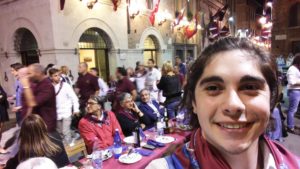
Overall, it was quite a remarkable experience. However, this was only the beginning of the excitement; the rest came tomorrow.
The Horse-race
The Palio itself is a biannual horse-race which takes place in Siena’s largest square, the Piazza del Campo. The race is only three laps around the piazza and usually lasts no longer than ninety seconds. However, there is a great deal of importance behind the race and Sienese residents take it very seriously. Each Contrada is represented by a horse and every time that Contrada wins, they are metaphorically reborn. Additionally, some Contradas have rivals, and it is even more important that one’s rival not win than that Contrada do well themselves. Although the race itself only lasts for roughly 90 seconds, it is by no means a short ordeal. There is a large procession which takes place beforehand, and the race does not start at a preordained time; rather, the last horse begins the race upon crossing the starting line and there is no time limit restricting how long they can wait.
My roommate and I were lucky enough to see the blessing of the Panther’s horse. This is exactly what it sounds like; the race horse is brought into the church of the Contrada and blessed. The crowd is absolutely silent.
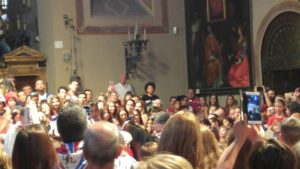
Afterwords, we watched the processions of individuals march around the city, finally entering the piazza just before 5 P.M. We were lucky, as we were within the last 100 people to be let in. Some of our friends had been waiting in the square since 11 A.M. Thankfully, they had staked out a nice spot by the railing. We joined them and watched the procession in the square.

Finally, the horses were led in with their jockeys. Unfortunately, one of the horses refused to behave. The tartuca horse (turtle) was too skittish to compete and so was eventually retired. However, this meant another hour of waiting for the race. After what seemed like an eternity, however, the Palio was run.

The Giraffe contrada ended up being the winner. I saw members of the contrada crying in the streets with joy. My friends and I ended up wandering the streets, observing the festivities, and eventually having an aperitivo at a local bar. We also returned to the campo at some point, where Giraffe members would occasionally come through in crowds while singing the song of their Contrada. Though it was exhausting, the Palio was unlike anything else I have ever seen. I like to think I’ll be tuning in on TV when the second one is run in August of this year.
